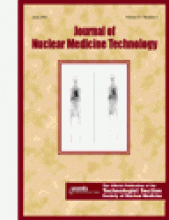Abstract
Bone scintigraphy performed on a patient during the middle of radiation therapy for an inoperable left lung malignancy showed diffusely increased uptake in the thoracic vertebrae and relatively increased uptake in the ribs of the left thorax. This bone scan finding is apparently a transient phenomenon that occurs in response to irradiation and eventually leads to photon deficiency or photopenia of the vertebrae. However, this transiently increased uptake of the thoracic spine, compared with uptake in the lumbar spine, mimics diffusely decreased uptake or photopenia of the lumbar vertebrae and may be misinterpreted as an effect of irradiation of the abdominal region. In the case of asymmetric uptake between the thoracic and lumbar spine, a carefully taken history of the timing and location of irradiation is necessary to avoid misinterpretation.
In patients undergoing radiation therapy, asymmetric uptake between the thoracic and lumbar spine may sometimes occur and may cause misinterpretation of findings, as the following case exemplifies.
CASE REPORT
A 71-y-old man was diagnosed with an inoperable adenocarcinoma of the lung and underwent external-beam radiation to the left lung mass. During his course of radiation therapy, a cumulative radiation dose of 20 Gy over 12 d of irradiation was given, and an additional 40 Gy was planned to be given in 2-Gy increments during the next 3 wk. On the last day of the initial 20-Gy irradiation, the patient was referred for 99mTc-hydroxymethylene diphosphonate bone scintigraphy. Bone images acquired 2 h after injection showed no evidence of skeletal metastasis; however, diffusely increased uptake in the thoracic vertebrae and relatively decreased uptake in the lumbar spine were noted (Fig. 1). In addition, there was faint increased uptake in the left mid lung field and relatively increased uptake in the ribs of the left thorax, compared with the ribs of the contralateral side.
Posterior (post) thoracic and lumbar images show diffusely increased activity in thoracic vertebrae, as indicated by arrows; decreased uptake in lumbar vertebrae, as indicated by arrowheads; and relatively increased uptake in ribs of left thoracic cage.
DISCUSSION
The finding of diffusely increased uptake in the thoracic vertebrae appeared to be the result of the 12 d of irradiation to the lung mass. In previous reports, irradiation appeared to be responsible for photopenia of the thoracic spine and lumbar spine in lung cancer (1,2) and renal cancer (3), respectively. Irradiation to the bone induces vasculitis and hyalinization of small vessels and results in interruption of the blood supply; in this situation, the delivery of the bone-imaging agent will be decreased or even interrupted. Concomitantly, the vessels of the bone marrow become inflamed, the small vessels undergo hyalinization, and interruption of the blood supply results. Eventually, aplastic bone marrow with replacement of red marrow by fatty tissue would result (4). Photopenia of the vertebrae may reflect fatty changes in the corresponding vertebral bone marrow. The finding of diffuse photopenia or photon deficiency in the thoracic spine usually occurs 2–6 mo after radiation therapy, may last for 26 mo (2), and is at least partially reversible, as shown at 3-y follow-up examinations (5). Diffusely increased uptake of bone-imaging agents in the thoracic vertebrae after irradiation of lung cancer has not been reported.
The diffusely increased uptake in the thoracic vertebrae, compared with uptake in the lumbar spine, that was seen in our patient might, if seen in a patient with renal cancer, be interpreted as diffusely decreased uptake in the lumbar spine resulting from radiation to the abdomen. Thus, vertebral photopenia and fatty changes of bone marrow may coexist after irradiation. A transient increase in localization of bone-imaging agents has been observed after irradiation (6). This phenomenon presumably resulted from a transient increase in blood flow and vascular permeability after irradiation (5,7).
This is what happened in our patient’s bone scintigraphic findings: higher uptake in the thoracic spine than in the lumbar spine, and slightly lower uptake in the ribs of the left thoracic cage than in the ribs of the opposite side. The finding of increased uptake in the thoracic spine might be misinterpreted as decreased uptake in the lumbar spine resulting from irradiation in the abdominal region (such as for renal carcinoma) or thoracic kyphosis (8). A carefully taken history of the timing and location of irradiation is necessary to avoid misinterpretation.
Footnotes
For correspondence or reprints contact: Wei-Jen Shih, MD, Nuclear Medicine Service, Lexington VA Medical Center, 1101 Veterans Dr., Lexington, KY 40502-2236.
E-mail: wshih0{at}pop.uky.edu








